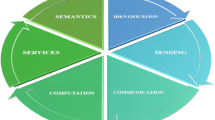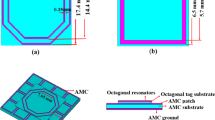Summary
"Hard to read tags" or missing reads are that type of tags, which cannot or can just hardly be read by an interrogator in passive UHF RFID systems. The reason of occurrence is predominantly caused by insufficient powering of the relevant tags. Several powering degradation factors affect the occurrence of "hard to read tags". In this paper, a typical gate application equipped with a passive UHF RFID system is investigated to recover these mostly application-specific degradation factors. A detailed field strength analysis of the gate area has shown that material properties of the tagged items, beam-width and quantity of the interrogator's transmit antennas, tag sensitivity and position of the tag have significant impact on the occurrence of missing reads. In conclusion, we can propose some alternatives to decrease the probability of missing reads. However, it is still not possible to design a perfect solution that prevents from missing reads with state of the art technology in any case.
Zusammenfassung
Als Lesefehler oder "schwer zu lesende Etiketten" in einem UHF RFID-System wird jene Gruppe von Etiketten bezeichnet, welche überhaupt nicht oder nur schwer von einem Lesegerät erfasst werden kann. Der Grund für ein solches Auftreten ist vorwiegend auf die unzureichende Energieversorgung der betroffenen Etiketten zurückzuführen. Mehrere Energieverlustsfaktoren beeinflussen das Auftreten von "schwer zu lesenden Etiketten". In diesem Artikel wird eine typische Torapplikation, ausgestattet mit einem passiven UHF RFID-System, untersucht, um diese meist anwendungsspezifischen Energieverlustfaktoren zu ermitteln. Eine ausführliche Feldstärkenanalyse des Torbereichs hat gezeigt, dass Materialeigenschaften der etikettierten Gegenstände, Öffnungswinkel und Anzahl der Leseantennen, Empfindlichkeit der Etiketten und Etikettenposition erheblichen Einfluss auf das Auftreten von Lesefehlern haben. Als Schlussfolgerung können wir einige Alternativen zur Minimierung der Lesefehlerwahrscheinlichkeit aufzeigen. Allerdings ist es mit der heutigen Technologie noch nicht möglich, eine perfekte Lösung zu finden, die das Auftreten von Lesefehlern unter allen Umständen verhindert.
Similar content being viewed by others
References
Bosselmann, P., Rembold, B. (2006a): Ray tracing simulations for UHF passive RFID applications. 15th IST Mobile and Wireless Communications Summit, Mykonos, Greece, 4–8 June, 2006.
Bosselmann, P., Rembold, B. (2006b): Ray tracing method for system planning and analysis of UHF-RFID applications with passive transponders. 2nd ITG/VDE Workshop on RFID, Erlangen, Germany, 4–5 July, 2006.
CISC RFID Field Recorder R 1.0 (http://www.cisc.at).
Fletcher, R, Marti, U. P., Redemske, R. (2005): Study of UHF RFID signal propagation through complex media. IEEE Antennas and Propagations Society Int. Symp. Vol. 1B. pp 747–750.
ISO Standards (2007): ISO 18000-6C Standard – RFID UHF air interface. Information technology – Radio frequency identification for item management – Part 6: Parameters for air interface communications at 860 MHz to 960 MHz.
Mitsugi, J., Hada, H. (2006): Experimental study on UHF passive RFID readability degradation. SAINT Workshops: 52–55.
Rappaport, T. S., McGillem, C. D. (1989): UHF fading in factories. IEEE Journal on Selected Areas in Communication, 7(1): 40–48.
Redemske, R., Fletcher, R. (2005): The design of UHF tag emulators with applications to RFID testing and data transport. Proc. of 4th IEEE Conf. on Automatic Identification Technologies, October 2005.
Author information
Authors and Affiliations
Rights and permissions
About this article
Cite this article
Mühlmann, U., Witschnig, H. "Hard to read tags": an application-specific experimental study in passive UHF RFID systems. Elektrotech. Inftech. 124, 391–396 (2007). https://doi.org/10.1007/s00502-007-0487-7
Received:
Accepted:
Issue Date:
DOI: https://doi.org/10.1007/s00502-007-0487-7




